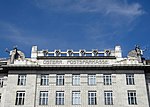Stubentor station
1991 establishments in AustriaAustrian railway station stubsBuildings and structures in Innere StadtRailway stations in Austria opened in the 20th centuryRailway stations opened in 1991 ... and 1 more
Vienna U-Bahn stations

Stubentor is a station on U3 of the Vienna U-Bahn. It was inaugurated in 1991 and is located in the Innere Stadt District. The station was named after the city gate located in the area up until 1858. Some relics of this gate, such as the remains of the old structures of the city walls, can be seen in the metro station. Stubentor is a three-story station, two tubes of Line U3 lined up on separate levels. The platform for trains bound for Simmering is above, and the platform for trains bound for Ottakring is below.
Excerpt from the Wikipedia article Stubentor station (License: CC BY-SA 3.0, Authors, Images).Stubentor station
Dr.-Karl-Lueger-Platz, Vienna Innere Stadt
Geographical coordinates (GPS) Address Nearby Places Show on map
Geographical coordinates (GPS)
| Latitude | Longitude |
|---|---|
| N 48.2071 ° | E 16.3801 ° |
Address
Dr.-Karl-Lueger-Platz
1010 Vienna, Innere Stadt
Austria
Open on Google Maps










